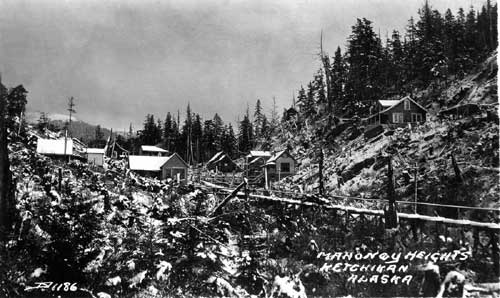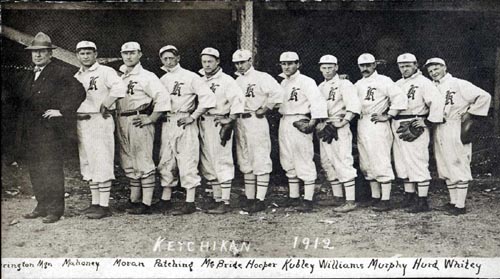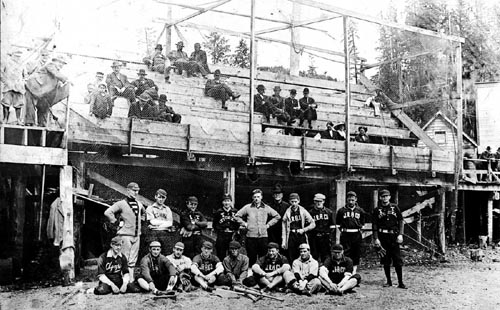 MAHONEY HEIGHTS, TODAY'S DEERMOUNT By DAVE KIFFER September 07, 2005
Joe Mahoney was a local miner and soda works operator who built one of the first homes in the area and helped develop this early Ketchikan subdivision just north of the Fidalgo Island Packing Cannery south of Ketchikan.  Photographer: David Nicoll; Donor: Irene McGillvray Photograph Courtesy Tongass Historical Society
As the infant city began to grow, prospectors began to stake Ketchikan's hillsides and uplands for potential claims. "The first recorded use of the area now known as the Deermount-Woodland neighborhood was prospecting for minerals," wrote state historian Rolfe Buzzell in a report that coincided with the widening of Deermount Street in the mid 1990s. "James A. Davis filed 37 lode claims on the ground above what is now the Stedman-Thomas District during 1904. Two of those claims, the Lotus and the Confidence, spilled over into what became the Deermount-Woodland area. But another miner, Joe Mahoney, actually built a small cabin in the area and residents were soon calling the area "Mahoney Heights." Mahoney - who primarily worked on mines in the George Inlet area and operated soda works both in downtown and Newtown - was also well-known as a local baseball player. He was a star third baseman on Ketchikan teams that frequently made the newspaper in the 1910s, facing off against teams from Juneau, Metlakatla, Anyox and Prince Rupert. Soon other residents were building frame houses in the area and a boardwalk was built from Stedman Street up the steep hillside into the area in prior to 1916. In the early 1920s, the residents of Mahoney Heights urged the City of Ketchikan to annex the neighborhood, according to Buzzell. In January of 1922, the city obtained title to 86 acres of land from the federal government which also included the cannery site and the uplands above the Stedman Thomas area. It was called the "Ketchikan Townsite Addition." The area was surveyed and two principal roads, Mahoney and Woodland, were laid out. Side streets such as Lotus, Alamo and Venetia Way were also laid out. According to city records, 195 "white" occupants lived in 78 dwellings in the area.  Photographer: Forest J. Hunt - Pictured: Puritan (Manager), Joe Mahoney, Moran, Patching, Mc Bride, Hooper, Kubley, Williams, Murphy, Hurd, Whitey Donor: Lawrence Kubley - Photograph courtesy Ketchikan Museums
In 1924, the city expanded the Mahoney Street boardwalk to accommodate horses and motor vehicle. A boardwalk was also built along Woodland Street. The Oct. 22, 1924 Chronicle reported that city workers were installing the first sewer lines into the area. "The first residents of Mahoney Heights were white middle class working people and small business owners," Buzzell wrote in 1993. "In 1924, the first Native family moved into the neighborhood when Casper Mather built a house on Woodland Avenue. The Episcopal Native School closed in downtown Ketchikan in 1925, prompting the federal government to build a school for Native children in Ketchikan." The November 17, 1926 edition of the Ketchikan Chronicle reported that work was commencing on the new school in Mahoney Heights. "The new building will be of frame structure, 52X60 feet and modernly equipped in every respect, accommodating approximately 90 children," the newspaper reported, adding that the total cost was in the range of $14,000. "There are three classrooms, closet space and three laboratories included in the plans. The building will be electrically lighted throughout." In April of 1927, the school was completed and inspected by Charles Hawksworth, the superintendent for the Indian Schools of Southeastern Alaska. "It is a very attractive structure built on Colonial lines and painted white," the Chronicle reported. "It is located on Mahoney Heights with a beautiful view of the channel and mountains." One year later, Bishop Peter S. Rowe of the Episcopal Church built St. Elizabeth's Church at the corner of Woodland Avenue and Mahoney Street. The Tsimpshian Native people built the church and Paul Mather was the first minister, according to Buzzell "Construction of the Bureau of Indian Affairs school and St. Elizabeth's Church prompted a number of Natives to move from Indian Town up the hill onto Mahoney Heights," Buzzell wrote. "Many were Native women married to white men during the 1930s, Mahoney Heights consisted of fishermen, laborers and middle class residents. The neighborhood was also ethnically mixed." In 1934, Mahoney Street's boardwalk was replaced with a graded road approximately 20 feet wide. In 1936, the city of Ketchikan changed the names of a more than two dozen streets in Ketchikan. Mahoney Street became Deermount Avenue. The name Mahoney Street was added to a small wooden boardwalk just up the hill from the BIA school. There is no record of why the name was changed, although by this point Joe Mahoney was living full-time in his mining cabin near his Mahoney Lake claims on George Inlet. "Residents continued to use both names (Mahoney and Deermount) for many years," Buzzell wrote. "And both names appeared on the 1946 Sanborn Fire Insurance Map." To further confuse the issue, many residents referred to "Deermont" Street rather than the official Deermount. That pronunciation continues to the present day.  Ketchikan ball team and grandstands over near mouth of the creek- where games played is where Federal Buidlings now stand -& had to stop when tied came in Jim Sayles- Ed Williams- & Laurence Kubley among those sitting on ground... (Scratched out Harw Stackpole- Clayton Smith)) 1st below John Patching, Jim Sayles -- Bob Robinson- Ed Williams-Jack Mac Bride Top row - Moran-Ed Richmond 2 unknown- Jim Smith; Fred Purinton- 3 unknown- Joe Mahony Donor: Bertha Hunt Wells - Photograph courtesy Ketchikan Museums
"Old time baseball fans will recall his playing in the early days, in the early 1900s," the Ketchikan Chronicle noted in its March 3, 1940 obituary. "He was a star of the game and a good man in any position on the field as well as a fine hitter. Mahoney was found in bed in his cabin. He may have died in his sleep." The neighborhood continued to grow during and after World War II and Deermount Street was extended past the intersection with Woodland Avenue. This area was known as upper Deermount and grew as workers from the pulp mill and other professionals settled there. In 1947, Alaska officially desegregated its schools and Native children began enrolling in the city schools. The BIA closed the Native school, although it was used for a time to house seventh and eighth grade students from the public schools as well as housing for teachers. The Alaska Native Brotherhood and Sisterhood purchased the property when it left its hall on Guthrie Way. In 1962, the Episcopal Church closed St. Elizabeth's and sold the building. It later became the Ketchikan Mortuary. The city continued to work on Deermount Street, replacing sewer lines and paving it in 1969. In 1978, the Ketchikan Indian Corporation replaced the BIA school building with a modern office building. In 1996, the State Department of Transportation widened lower Deermount to accommodate the increasing number of tour buses using the street to get to the Totem Heritage Center. By that point most of the historic houses along Deermount had been replaced by new structures, but at least two houses from the 1920s were torn down when the road was widened to 35 feet. Another property that was affected by the 1996 road project was Ireland Transfer and Storage, a company that had been in business in Ketchikan for nearly 80 years. The company closed down after it lost a significant amount of its property at the corner of Stedman and Deermount to the road project. Ironically, it had been forced
to move to the Deermount site in 1971 from its downtown location
when the state widened roads in that area.
Contact Dave at dave@sitnews.us Dave Kiffer ©2005
|